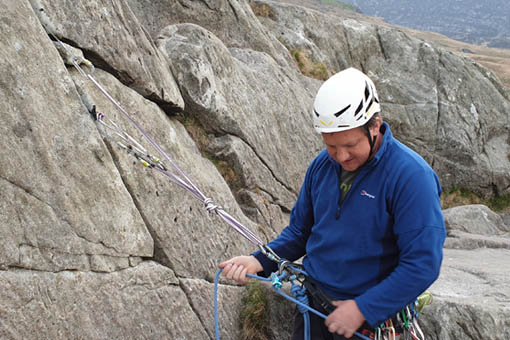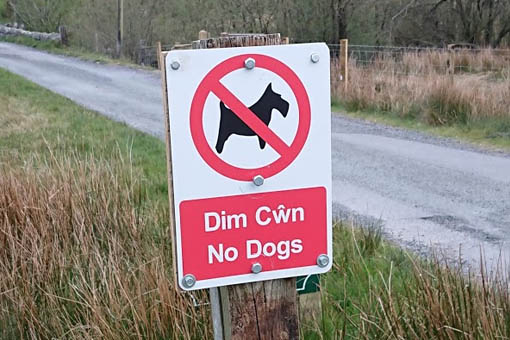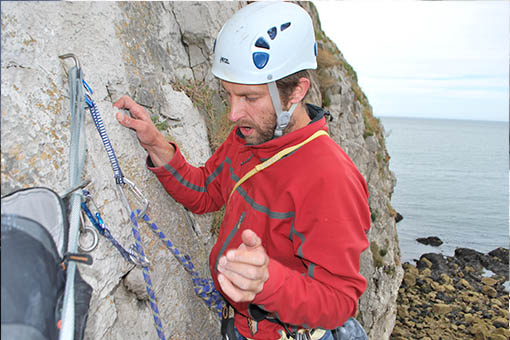Sea Cliff Climbing Courses
Coming Soon!
Please note, we are in the process of updating our website during the quiet winter period. During this time, some of the activities may become unavailable on the website. If you would like to discuss an activity then please drop us a message.
What will I Learn?
The list below explains the main learning objectives for this Lead Climbing course.
Abseiling
 [ Learn More... ]
[ Learn More... ]

Abseiling is the act of descending a rope, usually to get back down a cliff, or to get to the bottom of a sea cliff in order to start a climb. A friction device, commonly a belay device, is used to control the descent speed. On this course you will learn how to abseil safely, taking into consideration what happens in the event of an emergency such as the rope getting jammed in the belay device or a rock falling on you mid abseil.
[ Hide ]Ascending a rope
 [ Learn More... ]
[ Learn More... ]

Being able to ascend a rope is an important skill to learn when retreat down a cliff is not an option. This skill is often used at sea cliffs to quickly escape an incoming tide, or, in the event of a fall, usually at an overhanging cliff, where a climber is left dangling in space on the end of the rope.
[ Hide ]Avoiding injury
 [ Learn More... ]
[ Learn More... ]

The risks in climbing are numerous and each climbing discipline has its own hazards. Falling is the obvious risk, but you will also learn about other hazards relevant to the course. This could be warming up the muscles effectively, keeping out of the path of falling rocks, or prevent carabiners from being cross-loaded.
[ Hide ]Belay Stance
 [ Learn More... ]
[ Learn More... ]

As part of this course you will learn belay stance organisation. Keeping your belay stance organised is extremely important to efficient climbing. Without a well organised belay stance you could inadvertently force a fall because the rope has become stuck. We look at the most efficient belay setups to facilitate a smooth transition to climbing the next pitch, as well as how to organise your belay stance depending on who is going to be climbing next.
[ Hide ]Building a Belay
 [ Learn More... ]
[ Learn More... ]

In traditional climbing, where a climber places their own protection rather than relying on pre-placed bolts, when reaching the top of the climb a climber must construct a belay stance. This is usually a combination of equipment types which provide a single point in which to clip the rope. This makes it safe for their climbing partner to then start climbing up to the belay stance, retrieving any placed protection on their way. In order for this to be safe, the belay needs to be correctly equalised and have redundancy. On this course you will learn how to build a safe and efficient belay.
[ Hide ]Communication
 [ Learn More... ]
[ Learn More... ]

Good communication is imperative when climbing as a miscommunication could prove fatal. The biggest risk is usually the person on the ground letting go of the rope when the climber is attempting a difficult section. For example, a climber psychologically preparing themselves by saying "let's go" could easily be misinterpreted by their partner as "let go". On this course you will learn a set of standardised communication phrases which are intended to avoid such scenarios.
[ Hide ]Conservation
 [ Learn More... ]
[ Learn More... ]

At Climb Wales we take conservation seriously and this is embedded in all of the climbing and mountaineering courses that we offer. One of the many great things about climbing is interaction with nature. During the course we will look at how to minimise impact and ensure that future generations will be able to enjoy the same luxuries as we do.
[ Hide ]Equipment
 [ Learn More... ]
[ Learn More... ]

During the course you will learn to use a variety of climbing equipment. There are some aspects of equipment which are universal to all disciplines of climbing, such as climbing shoes, harness, helmet, ropes, belay devices and carabiners. Some items are specific to a particular discipline though and won't be the focus of other climbing courses, for example, during our multipitch climbing courses we will look at twin and half ropes but it's unlikely that these will be the focus of any of our other courses. On the sea cliff climbing course you will learn to use jumars and prusiks. And on the single pitch trad climbing course you will learn to place nuts, cams and hexes.
[ Hide ]Ethics
 [ Learn More... ]
[ Learn More... ]

Ethics has played an incredibly important part in shaping UK climbing, perhaps more so than in any other country. During this course you will learn about ethics in climbing and how it impacts what we do.
[ Hide ]Guidebooks
 [ Learn More... ]
[ Learn More... ]

As part of this climbing course you will learn how to read guidebooks, understand climbing grades, and find routes which are suited to your climbing abilities.
[ Hide ]Hanging Belays
 [ Learn More... ]
[ Learn More... ]

Hanging belays are used on steep climbing faces when you need to set up a belay but there is nowhere to stand. They are most commonly used in sea cliff climbing where perhaps the tide has come in and is covering the ledge at the bottom of the cliff, or in multipitch climbing when you've climbed so far that you've reached the end of the rope and have no choice but to set up an impromptu belay. As part of this course you will practice setting up hanging belays as well as how to manage the equipment in such a scenario.
[ Hide ]Jargon
 [ Learn More... ]
[ Learn More... ]

"I've got no friends and my nuts are too small" is a phrase that many climbers have found themselves shouting down to their climbing partners. Snatch the Gaston, Undercling the flatty, Flag into an Egyptian, Dyno to the Crimper, Mantle on the Sloper and get ready to Dog the Flash... By the end of this course you will speak climbing lingo with the best of them.
[ Hide ]Knots
 [ Learn More... ]
[ Learn More... ]

Knots are an integral part of climbing and an extremely important link in a chain intended to keep us alive. For sport climbing the most important knot is the figure-eight, for multipitch and trad we extend the use of knots further with clove and Italian hitches, prusiks, bowlines and more. As part of this climbing course you will learn to tie and inspect knots appropriate to the discipline of climbing and how to ensure their safety.
[ Hide ]Legislation
 [ Learn More... ]
[ Learn More... ]

During this climbing course you will learn about the legislation surrounding climbing, such as access permission, bird bans, and insurance.
[ Hide ]Loweroffs
 [ Learn More... ]
[ Learn More... ]

Loweroffs are found at the top of a sport climb. As part of this climbing course you will learn how to thread a loweroff so that you can get back down tot he ground and retrieve all of your climbing equipment without ever having put yourself in danger.
[ Hide ]Mental Game
 [ Learn More... ]
[ Learn More... ]

An irrational fear of falling is one of the biggest inhibitors in climbing. During this course you will learn how to manage fear as well as develop mental tactics to leverage your ability and ensure a good performance on the rock.
[ Hide ]Placing Protection
 [ Learn More... ]
[ Learn More... ]

To prevent a falling climber from hitting the floor, climbers periodically place climbing equipment into natural rock features as they climb. In the event of a fall, the equipment catches the rope and minimise the distance of a fall. On this course you will learn about how to place a variety or protection in different scenarios, the types of placements to avoid, and how to get creative when it seems like there is no way of protecting the next part of the climb.
[ Hide ]Protecting a second
 [ Learn More... ]
[ Learn More... ]

When leading a climb it is easy to focus too much on protecting yourself and not enough on making the climb safe for your partner who will climb behind you. On this climbing course you will learn about the situations where problems arise and how to avoid them.
[ Hide ]Prusiks
 [ Learn More... ]
[ Learn More... ]

Prusiks are an important part of the equipment arsenal and as they weigh so little so be present on almost any rack. On this course you will learn about the different types of prusiks and how to protect an abseil, to ascend a rope, to assist a belay and a host of other uses for prusiks.
[ Hide ]Retrieving a rope
 [ Learn More... ]
[ Learn More... ]

After abseiling on your rope it is necessary (unless on a sea cliff) to retrieve your rope so that it can be used again. On this course we learn how to rig belays so that the rope moves freely and how to avoid getting the rope caught.
[ Hide ]Ropes
 [ Learn More... ]
[ Learn More... ]

There are many types of ropes used in climbing; dynamic ropes, static ropes, single ropes, twin ropes, half ropes, hybrids, and many different weights and thicknesses from a number of manufacturers. During this climbing course you will learn to decide which rope to use for ta particular type of climbing.
[ Hide ]Throwing the rope
 [ Learn More... ]
[ Learn More... ]

When rigging an abseil from the top of the cliff it's important to make sure the rope reaches the ground. As part of this course you will learn a number of techniques to ensure this happens and how to recognise potential problems.
[ Hide ]Traversing
 [ Learn More... ]
[ Learn More... ]

Traversing is the name given to climbing sideways. Often in climbing you will find that the way above is bared, perhaps by a large overhanging obstacle, and the climber will therefore having to climb sideways to avoid the obstacle. Doing so can create a number of problems if it isn't managed correctly both for the lead climber and their climbing partner. On this climbing course you will learn how to traverse safely and avoid the problems which can arise.
[ Hide ]Booking Form
Have a Question?
We have answered many of our customers questions on our Frequently Asked Questions Page. If you cannot find the answer to your question then please feel free to send us a message.





